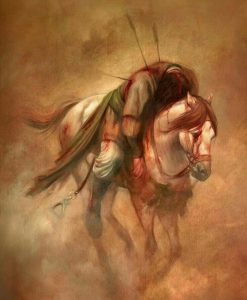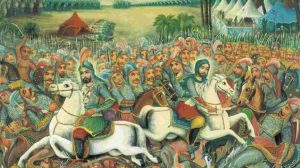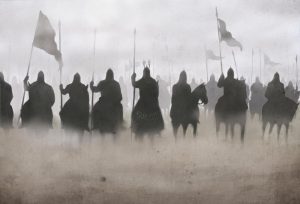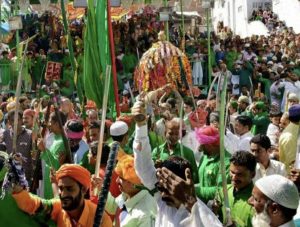The Hussaini Brahmins, a distinct community with a rich historical heritage, occupy a significant place in the narrative of Karbala, an event that has left an enduring impact on humanity’s conscience. Although the story of Imam Hussain (R.A.)’s sacrifice at Karbala is often regarded as a pivotal moment in Islamic history, its profound influence extends well beyond the confines of any single faith.
Historical Background of Karbala:
The history of Karbala is closely interwoven with the sacrifices made by Imam Hussain (R.A.) and his followers. After the martyrdom of Imam Hasan (R.A.), Imam Hussain (R.A.) found himself isolated in Madinah, as he refused to accept the corrupt and sinful Yazeed as the Caliph. When the people of Kufa sought his help but later betrayed him, Imam Hussain (R.A.) sent his cousin, Hazrat Muslim bin Aqeel (R.A.), to assess the situation, only for him to be martyred by Yazeed’s forces. Undeterred, Imam Hussain (R.A.) and his family, along with a small group of followers, decided to head to Kufa. However, they were surrounded by a massive army sent by Yazeed. Despite the dire situation, Imam Hussain (R.A.) steadfastly refused to pledge allegiance to Yazeed and valiantly fought against his oppressive rule. Ultimately, Imam Hussain (R.A.) and 72 members of his family and followers were brutally martyred in the scorching desert of Karbala, deprived of food and water.

Imam Hussain’s Connection With India:
Upon reaching Kufa with his immediate family and a few companions, Imam Hussain (R.A.) sought refuge in India, making an appeal to Yazeed’s army. However, his plea was rejected, and he, along with his family and companions, were subjected to a brutal martyrdom. Imam Hussain (R.A.) chose India for several reasons. India was predominantly a Hindu country at that time, and he did not wish to seek refuge in a region under Yazeed’s corrupt rule, where he believed his safety would be compromised. Moreover, his wife, Hazrat Shahar Bano (R.A.), was the sister of Chandra Lekha, the wife of Emperor Chandra Gupta and a Queen of an empire in India. This familial connection assured Imam Hussain of a welcoming reception in India. Historical accounts, including Raj Kumar Asthana’s book “Ancient India,” validate this fact. Additionally, Imam Hussain (R.A.)’s eldest son, H. Zainul Abedeen (R.A.), even wrote a letter to Emperor Chandra Gupta, seeking assistance in their fight against Yazid’s forces.

The Role of Hussaini Brahmins in Karbala:
The narrative of Karbala highlights the significant role of the Hussaini Brahmins, descendants of Rahab Sidh Dutt, a Hindu trader in Arabia who fought alongside Imam Hussain (R.A.) in Karbala. Legend has it that Rahab Dutt, being childless, expressed his wish for a son to Imam Hussain (R.A.), who blessed him with seven sons. Later, when Imam Hussain (R.A.) sought refuge in Karbala and was martyred, Dutt’s sons fought alongside him, laying down their lives for his cause. Rahab Dutt’s devotion and sacrifice earned him and his descendants the name “Hussaini Brahmins.”

One account tells of Rahab Dutt and his sons already being on their way to meet Imam Hussain when they learned of his migration from Mecca to Karbala. Upon reaching Karbala and discovering that the Imam had already been killed, they bravely pursued the murderers carrying Imam Hussain’s severed head towards Kufa. Despite facing immense challenges, Rahab Dutt managed to reclaim the Holy man’s head and treated it with great reverence, carrying it to Damascus. In a heartbreaking act of sacrifice, when Yazeed’s men demanded the head of Imam Hussain, Rahab Dutt beheaded one of his sons and offered his severed head, but they claimed it wasn’t the Imam’s. He repeated this heart-wrenching act with all seven of his sons, refusing to part with Imam Hussain’s head. Finally, a year later, the head was laid to rest in Damascus.
The brave Dutts and followers of Imam Hussain did not lay down their weapons until they saw the end of Yazeed’s rule, which was tainted by the tragedy of Karbala. Under the leadership of one Bhurya Dutt, the remaining Dutts remained in Kufa, while Rahab Dutt bid farewell to Arabia, choosing to remain amongst the Brahmins. Ameer Mukhtar Saqafi, chief of the partisans of Imam Hussain, arranged for the Dutts to settle in a special part of Kufa, known today as Dair-i-Hindiya or ‘the Indian quarter.’ Even before the Karbala incident, Imam Hussain’s father, Hazrat Ali, had entrusted the Dutts with the responsibility of the public exchequer during the Battle of Jamal fought near Basra against Omayad Caliph Muawiya, Yazeed’s father. This underscores the significant role played by the pragmatic Dutt Mohyals in the history of Karbala.
Subsequently, when the Omayads unleashed a campaign of vengeance against the disciples of Imam Hussain, the remaining Dutts, along with many Syeds (descendants of the Holy Prophet), migrated to India in 778 AD. The Dutts settled in Dina Nagar, District Sialkot, and some ventured as far as Pushkar in Rajasthan, where they formed their own community and adopted the name Hussaini Brahmins, preserving the memory of their connection with the Imam.

In Conclusion:
The historical account of the Hussaini Brahmins and their association with Karbala illustrates the lasting impact of Imam Hussain (R.A.)’s sacrifice. Their unity and cooperation with Muslims during this momentous event showcase the unifying power of universal values like truth, justice, and compassion, transcending cultural and religious boundaries. The legacy of the Hussaini Brahmins stands as a testament to the enduring universality of the message of Karbala, continuing to inspire and guide humanity in the present era.
Disclaimer
The information in the above article is derived from a variety of reputable and widely available resources, which have been carefully selected to provide a comprehensive overview of the subject matter.
It is important to note that history, by its nature, is multifaceted and often subject to interpretation and revision. Different historians and scholars may analyze events and figures from varying perspectives, leading to the existence of diverse versions of historical accounts. While every effort has been made to present accurate and reliable information, the author and publisher of this article cannot guarantee its absolute accuracy or completeness. Historical research is an ongoing process, and new evidence or perspectives may emerge that could potentially alter the understanding of past events.
In conclusion, this article serves as a starting point for exploration into the subject matter but should not be considered the definitive or sole source of historical knowledge. We encourage readers to engage in their own research and critical thinking to gain a broader and deeper understanding of historical topics.









What do you think?
You must be logged in to post a comment.